‘APAC CIO Outlook’ Magazine Features Content from ‘Agile Transformation’ Book by Scott M. Graffius
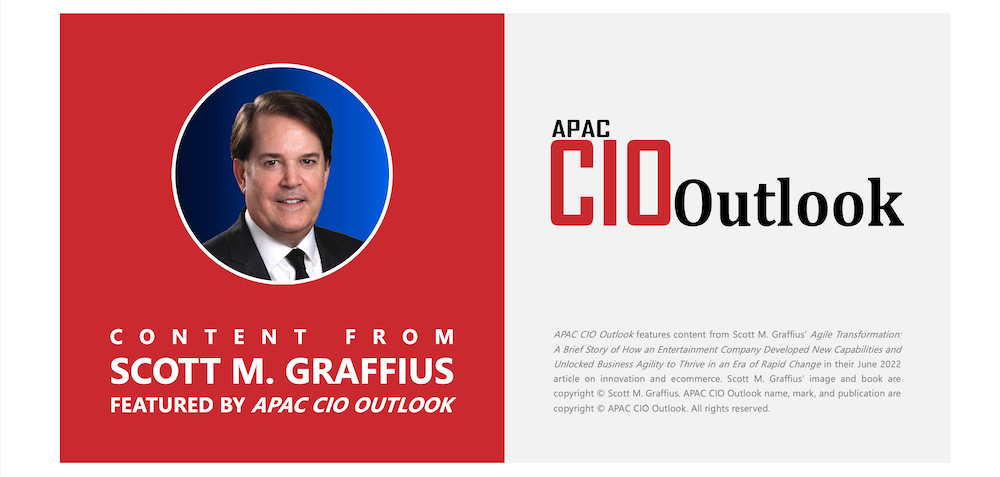
Click here to download this article as a PDF.
APAC CIO Outlook magazine features content from Scott M. Graffius’ Agile Transformation: A Brief Story of How an Entertainment Company Developed New Capabilities and Unlocked Business Agility to Thrive in an Era of Rapid Change in their June 2022 article on innovation and e-commerce. An excerpt is shown below.
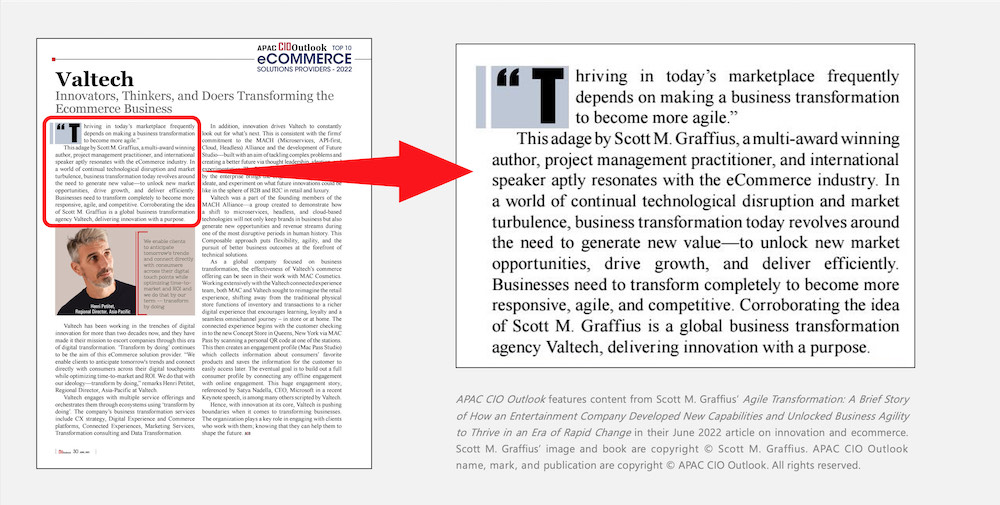

About APAC CIO Outlook Magazine
APAC CIO Outlook is a digital and print magazine that provides a platform for CIOs, CTOs and other senior level IT buyers and decision makers along with CXOs of solution providers to share their experiences, wisdom, and advice with enterprise IT community of Asia-Pacific (APAC) countries. To learn more, visit https://www.apacciooutlook.com.



About Scott M. Graffius

Scott M. Graffius, PMP, CSP-SM, CSP-PO, CSM, CSPO, SFE, ITIL, LSSGB is an agile project management practitioner, consultant, multi award-winning author, and highly sought-after international keynote speaker. He has generated over $1.75 billion of business value in aggregate for the organizations he has served. Graffius is the CEO and Principal Consultant at Exceptional PPM and PMO Solutions™ and subsidiary Exceptional Agility™. Content from his books, talks, workshops, and more have been featured and used by businesses, professional associations, governments, and universities. Select examples include Microsoft, Oracle, Broadcom, Cisco, Gartner, Project Management Institute, IEEE, U.S. Soccer Federation, Qantas, National Academy of Sciences, U.S. Department of Energy, U.S. National Park Service, New Zealand Ministry of Education, Yale University, Warsaw University of Technology, and others. Graffius has delighted audiences with dynamic and engaging talks and workshops on agile, project management, and technology leadership at 82 conferences and other events across 24 countries.
His full bio is available here.
Connect with Scott on:
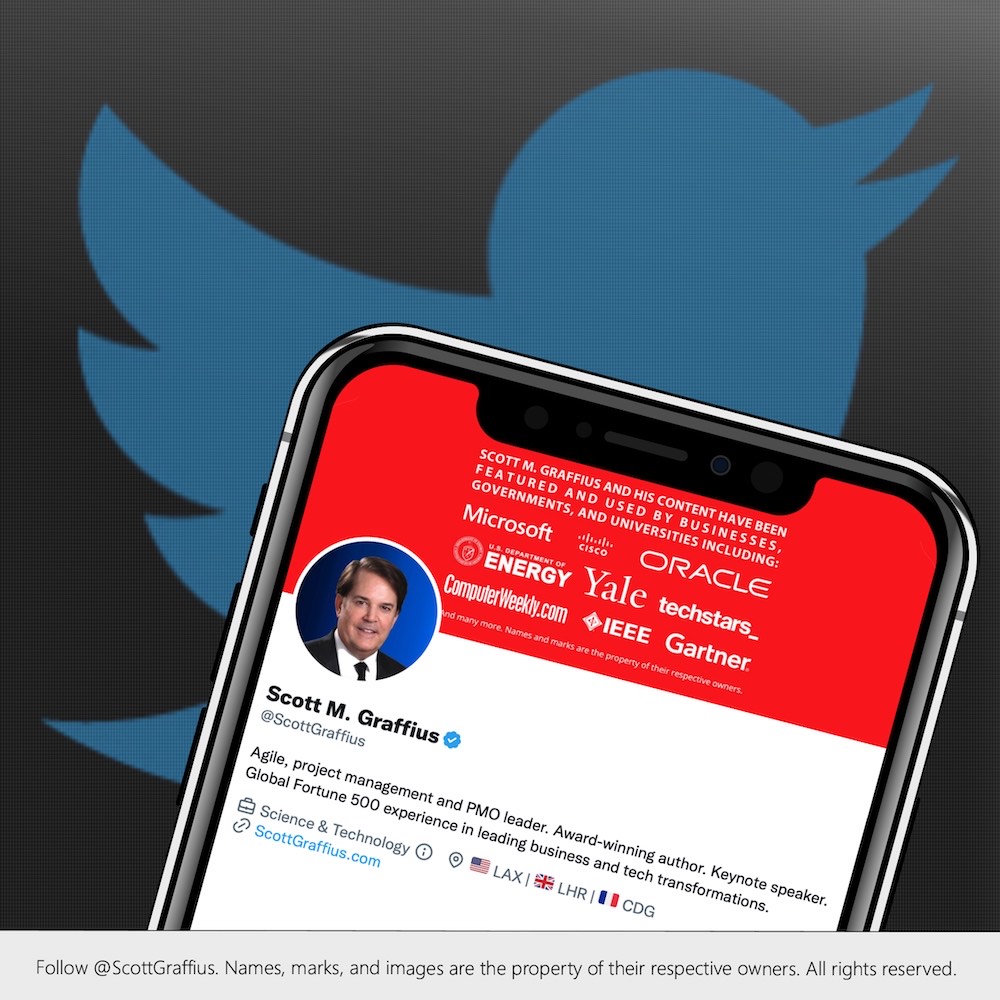

About Agile Scrum: Your Quick Start Guide with Step-by-Step Instructions
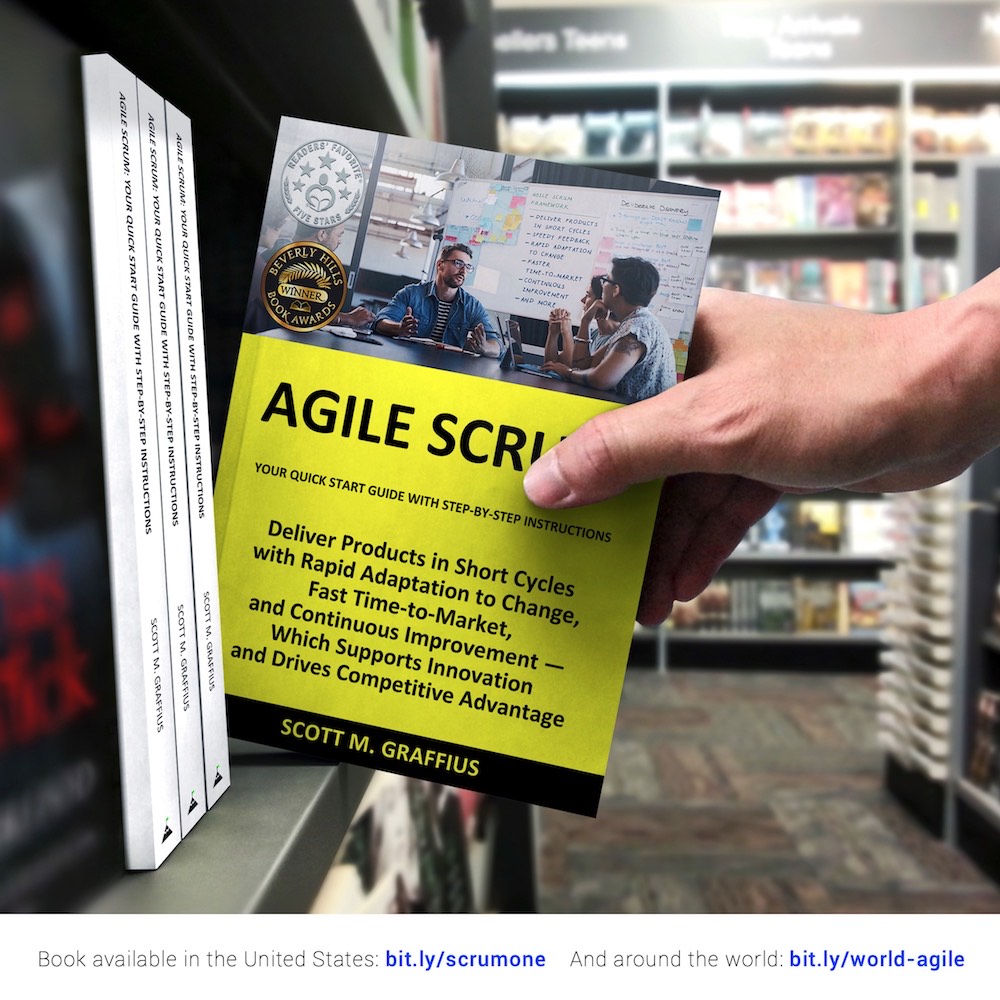
Shifting customer needs are common in today's marketplace. Businesses must be adaptive and responsive to change while delivering an exceptional customer experience to be competitive.
There are a variety of frameworks supporting the development of products and services, and most approaches fall into one of two broad categories: traditional or agile. Traditional practices such as waterfall engage sequential development, while agile involves iterative and incremental deliverables. Organizations are increasingly embracing agile to manage projects, and best meet their business needs of rapid response to change, fast delivery speed, and more.
With clear and easy to follow step-by-step instructions, Scott M. Graffius's award-winning Agile Scrum: Your Quick Start Guide with Step-by-Step Instructions helps the reader:
- Implement and use the most popular agile framework―Scrum;
- Deliver products in short cycles with rapid adaptation to change, fast time-to-market, and continuous improvement; and
- Support innovation and drive competitive advantage.
Hailed by Literary Titan as “the book highlights the versatility of Scrum beautifully.”
Winner of 17 first place awards.
Agile Scrum: Your Quick Start Guide with Step-by-Step Instructions is available in paperback and ebook/Kindle in the United States and around the world. Some links by country follow.
- 🇧🇷 Brazil
- 🇨🇦 Canada
- 🇨🇿 Czech Republic
- 🇩🇰 Denmark
- 🇫🇮 Finland
- 🇫🇷 France
- 🇩🇪 Germany
- 🇬🇷 Greece
- 🇭🇺 Hungary
- 🇮🇳 India
- 🇮🇪 Ireland
- 🇮🇱 Israel
- 🇮🇹 Italy
- 🇯🇵 Japan
- 🇱🇺 Luxembourg
- 🇲🇽 Mexico
- 🇳🇱 Netherlands
- 🇳🇿 New Zealand
- 🇳🇴 Norway
- 🇪🇸 Spain
- 🇸🇪 Sweden
- 🇨🇭 Switzerland
- 🇦🇪 UAE
- 🇬🇧 United Kingdom
- 🇺🇸 United States

About Agile Transformation: A Brief Story of How an Entertainment Company Developed New Capabilities and Unlocked Business Agility to Thrive in an Era of Rapid Change
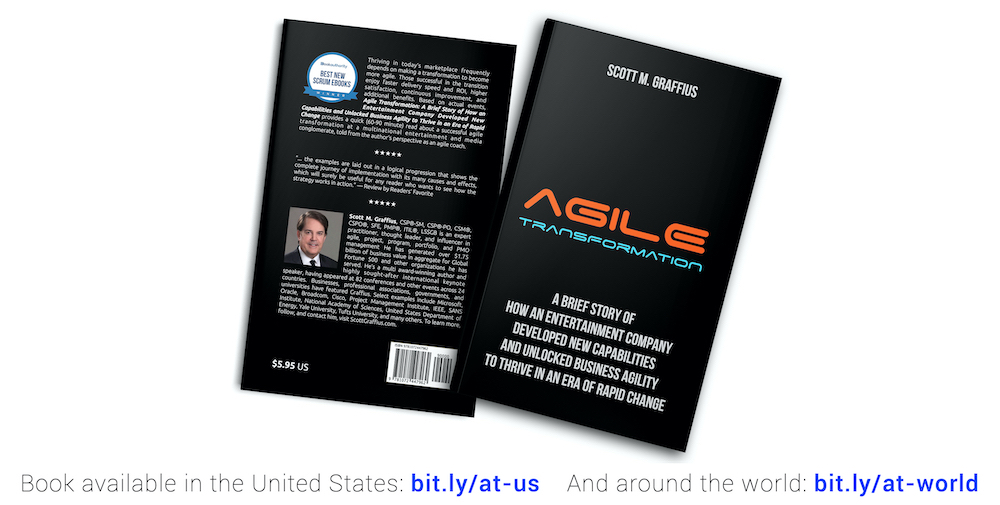
Thriving in today's marketplace frequently depends on making a transformation to become more agile. Those successful in the transition enjoy faster delivery speed and ROI, higher satisfaction, continuous improvement, and additional benefits.
Based on actual events, Agile Transformation: A Brief Story of How an Entertainment Company Developed New Capabilities and Unlocked Business Agility to Thrive in an Era of Rapid Change provides a quick (60-90 minute) read about a successful agile transformation at a multinational entertainment and media company, told from the author's perspective as an agile coach.
The award-winning book by Scott M. Graffius is available in paperback and ebook/Kindle in the United States and around the world. Some links by country follow.
- 🇦🇺 Australia
- 🇦🇹 Austria
- 🇧🇷 Brazil
- 🇨🇦 Canada
- 🇨🇿 Czech Republic
- 🇩🇰 Denmark
- 🇫🇮 Finland
- 🇫🇷 France
- 🇩🇪 Germany
- 🇬🇷 Greece
- 🇮🇳 India
- 🇮🇪 Ireland
- 🇯🇵 Japan
- 🇱🇺 Luxembourg
- 🇲🇽 Mexico
- 🇳🇱 Netherlands
- 🇳🇿 New Zealand
- 🇪🇸 Spain
- 🇸🇪 Sweden
- 🇨🇭 Switzerland
- 🇦🇪 United Arab Emirates
- 🇬🇧 United Kingdom
- 🇺🇸 United States

The short URL for this article is: https://bit.ly/apac-cio
© Copyright 2023 Scott M. Graffius. All rights reserved. This material may not be published, broadcast, rewritten or redistributed without the express written permission of Scott M. Graffius.

The Protocol for Reporting an Error to an Author or Publisher
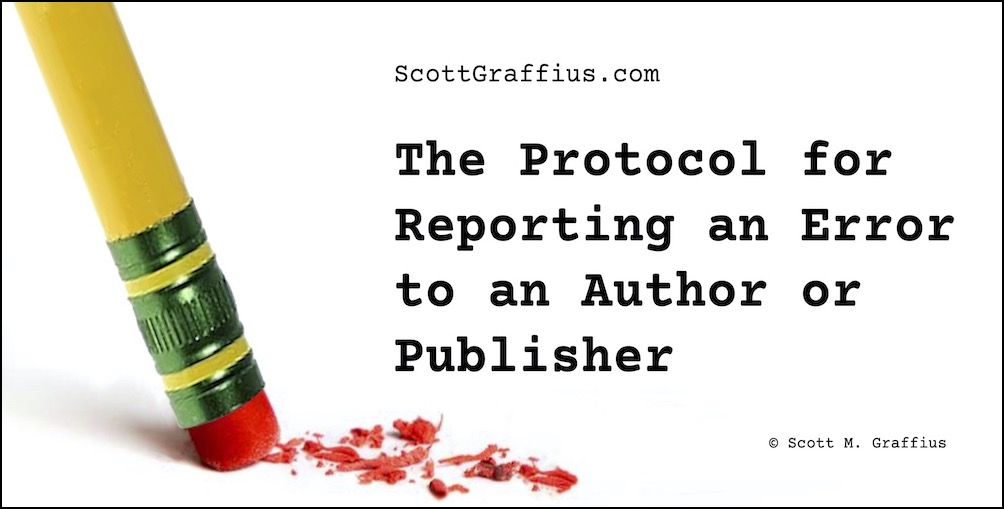

This article covers what to do if you find an error in a book, scientific paper, or other publication. Including supporting information, it's organized into eight sections:
- Introduction
- How to Report an Error
- A Real Example of Reporting an Error
- What Happens After You Report an Error
- Conclusion
- Glossary of Terminology
- References
- How to Cite This Article
This article does not cover how to handle violation of copyrights or other intellectual property (IP) rights. For IP cases, it is recommended that you consult a qualified attorney.


Introduction
Have you encountered a typo in a book or a factual error in a scientific paper? Errors, whether minor typos or significant inaccuracies, can compromise the credibility, readability, and utility of published works. However, you can make a difference. By reporting these errors to the author or publisher, you contribute to advancing the integrity and value of the respective information.
This article will equip you with information to report errors effectively, irrespective of the subject matter. From identifying the error and crafting a clear report to understanding what happens post-submission, each step is covered. Whether it's enhancing the experience for future readers or upholding the accuracy and integrity of scientific works, your vigilance and action in reporting errors plays a pivotal role.


How to Report an Error
If you discover an error in a publication, here are the recommended steps for reporting it:
STEP 1: Is there a newer edition or update to the publication?
1A. Yes, there is a newer edition or update.
XXX 1A1. Is the error resolved in the newer edition or update?
XXX XXX 1A1A. If yes to 1A1, the error is resolved in the newer edition or update, then no further action is needed.
XXX XXX 1A1B. If no to 1A1, then go to STEP 2.
1B. If no, there is not a newer edition or update, then go to STEP 2.
STEP 2: Is there a publisher’s web page for the publication, or an author’s website which mentions the publication, or an errata/corrections list for the publication at any location (Google the publication’s title and "AND errata OR corrections")?
2A. Yes, there’s a publisher's web page for the publication, an author's website which mentions the publication, or an errata/corrections list for the publication at any location
XXX 2A1. Is the error referenced?
XXX XXX 2A1A. If yes to 2A1, then no further action is needed.
XXX XXX 2A1B. If no to 2A1, then go to STEP 3.
2B. If No, there is not a publisher's web page for the publication, or an author's website which mentions the publication, or an errata/corrections list for the publication at any location, then go to STEP 3.
STEP 3: Does the publication specify the process for reporting an error?
3A. If yes, the publication specifies the process for reporting an error, then follow it to report the error.
3B. If no, the publication does not specify the process for reporting an error, then go to STEP 4.
STEP 4: Does the publisher’s website or author’s website specify the process for reporting an error?
4A. If yes, the publisher’s website or author’s website specifies the process for reporting an error, then follow it to report the error.
4B. If no, neither the publisher’s website nor the author’s website specifies the process for reporting an error, then go to STEP 5.
STEP 5: Does the publication include an email address for the publisher or author?
5A. If yes, the publication includes an email address for the publisher or author, then use it to send an email with your report of the error.
5B. If no, the publication does not include an email address for the publisher or author, then go to STEP 6.
STEP 6: Does the publisher’s website or the author’s website include an email address?
6A. If yes, the publisher’s website or the author’s website includes an email address, then use it to send an email with your report of the error.
6B. If no, the publisher’s website or the author’s website does not include an email address, then go to STEP 7.
STEP 7: Can you find an email address for the publisher or author via other means (such as a Google search)?
7A. If yes, you found an email address for the publisher or author, then use it to send an email with your report of the error.
7B. If no, you could not find an email address for the publisher or author, then you may — or may not — want to contact the publisher or author via another method (such as a direct message on social media).

Suggestions for reporting an error via email:
- In the subject line of your email, note “Reporting an error in [name of publication]”
- In the main part of your email, reiterate that you’re writing to report an error in [name of publication]. Specify the page number(s)/location(s) of the respective content and delineate the error or problem. Provide as many details are practical.
- In the closing part of your email, note your email address (even if it’s the same email you used to send the report).

A Real Example of Reporting an Error
A Guide to the Project Management Body of Knowledge (PMBOK® Guide) is the Project Management Institute’s flagship publication and is a fundamental resource for effective project management in any industry. The book is the global, gold standard for project management. The PMI released the seventh edition of the PMBOK Guide on August 1, 2021.
On November 4, 2021, Scott M. Graffius discovered that a factual error was introduced into the seventh edition of the PMBOK Guide.
The PMI has a process to handle such problems. If/when errors are discovered, the PMI instructs individuals to share findings by completing the PMI Standards Program Comment Form and emailing it to the PMI. The form has two sections: Comment and Suggested Change. Graffius completed the form.
Here’s what Graffius wrote in the Comment section: “Section 4.2.6.1 Tuckman Ladder includes: ‘Bruce Tuckman articulated the stages of team development as forming, storming, norming, and performing. Many people add a fifth stage, adjourning.’ The passage is misleading and incorrect. Here’s why. In 1965, Bruce Tuckman introduced his model inclusive of four stages: forming, storming, norming, and performing. (The source/citation: Tuckman, B. W. (1965). Developmental Sequence in Small Groups. Psychological Bulletin, 63: 384-399.) However, Tuckman subsequently discovered adjourning to be so important that he updated his own model in 1977 to include adjourning. (The source/citation: Tuckman, B. W., & Jensen, M. A. C. (1977). Stages of Small-Group Development Revisited. Group and Organizational Studies, 2 (4): 419- 427.) Tuckman says there are five stages: forming, storming, norming, performing, and adjourning. By not including that relevant, informative, and helpful fact — and instead vaguely saying ‘Many people add a fifth stage, adjourning.’ — the passage is misleading and incorrect.”
Here's what Graffius wrote in the Suggested Change section: “For the reason detailed in the Comment section of this form, I suggest changing the passage from ‘Bruce Tuckman articulated the stages of team development as forming, storming, norming, and performing. Many people add a fifth stage, adjourning.’ to: ‘Bruce Tuckman articulated the stages of team development as forming, storming, norming, performing, and adjourning.’ or ‘Bruce Tuckman articulated the stages of team development as forming, storming, norming, performing, and adjourning. He introduced the first four stages in 1965, and he added the fifth stage when he updated his model in 1977.’”
The completed Standards Program Comment Form also included Graffius’ name and email address. He emailed the form to the PMI on November 4, 2021.
What happened next? The story is here.

What Happens After You Report an Error
Error handling varies by organization. Generally, excerpt for cases where a minor error is concerned, any necessary changes (such as updating the publication) will be accompanied by a post-publication notice, which will be linked to the original publication. These changes can take the form of a Correction notice, an Expression of Concern, a Retraction, or a Removal. The four forms are delineated next.
- Correction Notice. When a work is impacted by an error (or omission) but the scholarly integrity remains intact, a Correction Notice or similar communication will be issued. Some publishers classify errors as major or minor. With that bifurcation, major errors (such as missing text) are addressed by a Correction Notice, and minor errors (such as typos) are addressed by either a Correction Notice or another action — such as a footnote or other notation added to the publication detailing that the publication has been corrected.
- Expression of Concern. In certain cases, such as a protracted active investigation into potential research or publication misconduct, an Expression of Concern may be issued. At the conclusion of the investigation, a Correction Notice or Retraction may be disseminated.
- Retraction. Where a major error invalidates the academic integrity of the publication or where misconduct has taken place, a Retraction will be issued.
- Removal. In circumstances where problems cannot be handled via a Correction Notice or Retraction, a Removal will be performed. Note: This is rare.
Forms/notices may be called an erratum (plural: errata) or a corrigendum (plural: corrigenda). See the Glossary section of this article for details.


Conclusion
This article provided information on how to report errors effectively. From identifying the problem and crafting a clear report to understanding what happens post-submission, this article shined a light on each step. Whether it's enhancing the experience for future readers or upholding the accuracy and integrity of scientific works, your vigilance and action in reporting errors plays a pivotal role.


Glossary of Terminology
- Addendum. Used for additional information that wasn't available at the time of publication but needs to be included for completeness.
- Correction Notice. A broad term that can encompass any of the following scenarios. When a work is impacted by an error (or omission) but the scholarly integrity remains intact, a Correction Notice or similar communication will be issued. Some publishers classify errors as major or minor. With that bifurcation, major errors are addressed by a Correction Notice, and minor errors are addressed by either a Correction Notice or another action — such as a footnote or other notation added to the publication detailing that the publication has been corrected.
- Corrigenda. See: Corrigendum.
- Corrigendum. Singular: Corrigendum. Plural: Corrigenda. Formality: Corrigendum is a more formal term used to correct errors in books, journals, or other publications. Publication: A corrigendum is typically issued by the publisher as a separate notice that accompanies the original publication. Scope: It usually addresses significant errors that affect the overall content, such as factual inaccuracies, incorrect data, or major typos. Format: A corrigendum provides a clear description of the errors and the corrected information, usually including page numbers or sections where the corrections should be applied. Also see: Errata, Major Error, Minor Error.
- Errata. Singular: Erratum. Plural: Errata. Formality: Errata is a more informal term used to indicate errors in books, articles, or other publications. Inclusion: Errata may be included directly in the publication itself, often as a list of corrections at the beginning or end of the book or article. Scope: It can address both minor and major errors. Format: Errata are usually presented as a list, highlighting the errors and providing the corrected information without the formal structure of a corrigendum. Also see: Corrigendum.
- Erratum. See: Errata.
- Factual Error. An inaccuracy in the information presented. Factual errors are usually considered to be major errors.
- Formatting Error. Mistakes related to layout, style, or referencing. Formatting errors are usually considered to be minor errors.
- Major Error. Major errors are errors or omissions (such as missing text) that can impact the interpretation of the publication but where the scholarly integrity of the work remains intact. Also see: Minor Error.
- Minor Error. Minor errors are errors (such as typos or formatting errors) which do not impact the readers’ understanding of the content. Also see: Major Error.
- Reader Report. In academic publishing, this refers to feedback provided by reviewers who identify errors or suggest improvements before publication.
- Retraction. A retraction is a disavowal of a work. It's typically done when findings in the work are not considered trustworthy due to scientific misconduct or error — when a significant error invalidates the findings or conclusions, when the work is found to have plagiarized or infringed on the copyright of another work, or when the work is found to have violated ethical guidelines.
- Typo. The term typo is short for typographical errors (e.g., spelling and grammar mistakes). Typos are classified as minor errors.


References/Sources
- Alter, Alexandra (2019, September 22). It’s a Fact: Mistakes are Embarrassing the Publishing Industry. Available at: https://www.nytimes.com/2019/09/22/business/publishing-books-errors.html.
- American Psychological Association (2019, November). Correction Notices. Available at: https://apastyle.apa.org/style-grammar-guidelines/research-publication/correction-notices.
- Association for Computing Machinery (ACM) (2018, November 15). ACM Publications Policy on the Withdrawal, Correction, Retraction, and Removal of Works from ACM Publications and ACM DL. Available at: https://www.acm.org/publications/policies/retraction-policy.
- Cambridge University Press (n.d.). Publishing Ethics. Available at: https://www.cambridge.org/core/journals/flow/information/journal-policies/publishing-ethics.
- Committee on Publication Ethics (COPE) (n.d.). Post-Publication Discussions and Corrections. Available at: https://publicationethics.org/postpublication.
- Elsevier (n.d.). Policy and Best practice: Errata & Corrigenda. Available at: https://www.elsevier.com/editor/perk/policy-and-best-practice-errata-and-corrigenda.
- Emerald Publishing (n.d.). Article Withdrawal & Correction. Available at: https://www.emeraldgrouppublishing.com/publish-with-us/author-policies/article-withdrawal-correction.
- Faust, Jessica (2007, October 3). Typos and Errors After Publication. Available at: https://bookendsliterary.com/typos-and-errors-after-publication.
- Graffius, Scott M. (2021, November 10). An Error Was Introduced Into the Seventh Edition of 'A Guide to the Project Management Body of Knowledge (PMBOK)'. Available at: https://scottgraffius.com/blog/files/pmbok7.html.
- Idunn (n.d.). Publishing and Research Ethics Policy. Available at: https://www.idunn.no/info/publiseringsetikk.
- IEEE (n.d.). Publishing Ethics: Guidelines and Policies: Post-Publication Policies. Available at: https://books.ieeeauthorcenter.ieee.org/book-publishing-at-ieee/publishing-ethics/guidelines-and-policies/post-publication-policies.
- Institute for Operations Research and the Management Sciences (INFORMS) (n.d.). Guidelines for Ethical Behavior in Publishing. Available at: https://pubsonline.informs.org/page/opre/guidelines-for-ethical-behavior-in-publishing.
- IntechOpen (n.d.). Retraction and Correction Policy. Available at: https://www.intechopen.com/page/retraction-and-correction-policy.
- Marasović, Tea; Utrobiĉić, Ana; and Maruŝić, Ana (2018, March 31). Transparency of Retracting and Replacing Articles. The Lancet, 391 (10127): 1244-1245.
- Nature (n.d.). Editorial and Publishing Policies. Available at: https://www.nature.com/srep/journal-policies/editorial-policies.
- O’Reilly Media (n.d.). Errata for Java in a Nutshell. Available at: https://www.oreilly.com/catalog/errata.csp?isbn=0636920030775.
- Palgrave Macmillan (n.d.). Corrections and Retractions. Available at: https://www.palgrave.com/gp/editorial-policies/corrections-and-retractions.
- Pearson Education / InformIT (n.d.). Contact Us: Submit Errata. Available at: https://www.informit.com/about/contact_us/index.aspx?ContactUs_Topics_Partners_id=9d39709c-c911-4c96-ac2c-2c5a22d68ba9.
- Project Management Institute (PMI) (n.d.). PMI Standards Program Comment Form. Available at: https://www.pmi.org/-/media/pmi/documents/public/pdf/pmbok-standards/pmi-standards-program-comment-form.pdf.
- Project Management Institute (PMI) (n.d.). Standards Errata Sheets. Available at: https://www.pmi.org/pmbok-guide-standards/foundational/pmbok/errata-sheets.
- Public Library of Science (PLOS) (n.d.). Corrections, Expressions of Concern, and Retractions. Available at: https://journals.plos.org/plosone/s/corrections-and-retractions.
- SAE International (n.d.). ARINC Standard – Errata Report Template. Available at: https://wcm14.sae.org/site/binaries/content/assets/itc/content/arinc/errata-form.docx [note: selecting the link will download the file].
- Sage Publications (n.d.). Sage Corrections and Retractions Policy. Available at: https://us.sagepub.com/en-us/nam/sage-corrections-and-retractions-policy.
- Science Publishing Group (n.d.). Ethical Guidelines. Available at: https://www.sciencepublishinggroup.com/information/ethical-guidelines.
- Springer (n.d.). Editorial Policies: Corrections and Retractions. Available at: https://www.springer.com/gp/editorial-policies/corrections-and-retractions.
- Taylor & Francis (n.d.). Publishing Ethics for Journal Editors: FAQs. Available at: https://editorresources.taylorandfrancis.com/publishing-ethics-for-editors/publishing-ethics-faqs.
- Ubiquity Press (n.d.). Correction and Retraction Policy. Available at: https://ubiquitypress.com/site/corrections.
- Warner, Brooke (2019, April 26). How to Publish a Perfect Book. Available at: https://www.publishersweekly.com/pw/by-topic/authors/pw-select/article/79902-how-to-publish-a-perfect-book.html.
- Wiley (n.d.). Best Practice Guidelines on Research Integrity and Publishing Ethics. Available at: https://authorservices.wiley.com/ethics-guidelines/index.html.
- Wiley Author Services (n.d.). Wiley's Policy for Handling Retractions, Withdrawals, and Expressions of Concern. Available at: https://authorservices.wiley.com/ethics-guidelines/retractions-and-expressions-of-concern.html.
- World Intellectual Property Organization (WIPO) (n.d.). Managing Intellectual Property in the Book Publishing Industry. Available at: https://www.wipo.int/edocs/pubdocs/en/copyright/868/wipo_pub_868.pdf.


How to Cite This Article
Graffius, Scott M. (2024, March 22). The Protocol for Reporting an Error to an Author or Publisher. Available at: https://scottgraffius.com/blog/files/error-reporting.html. DOI: 10.13140/RG.2.2.18830.98883.


Post-Publication Notes
If there are any supplements or updates to this article after the date of publication, they will appear here.
After the article was published, Scott M. Graffius developed a flowchart of the suggested steps for reporting an error. The flowchart is a draft and it is subject to change.




About Scott M. Graffius

Scott M. Graffius, PMP, SA, CSP-SM, CSP-PO, CSM, CSPO, ITIL, LSSGB is an agile project management practitioner, consultant, thinker, creator, multi-award-winning author, and international public speaker. Founder and CEO of Exceptional PPM and PMO Solutions™ and subsidiary Exceptional Agility™, he has generated over $1.9 billion for Global Fortune 500 businesses and other organizations he has served. Graffius and content from his books, talks, workshops, and more have been featured and used by Microsoft, Oracle, Broadcom, Cisco, Gartner, Project Management Institute, IEEE, National Academy of Sciences, United States Department of Energy, Yale University, Tufts University, and others. He delights audiences with dynamic and engaging talks and workshops on agile project management, AI, Tech leadership, video game development, strategic alignment, the science of high performance teams, and more. To date, he's presented sessions at 89 conferences and other events across 25 countries.
His full bio is available here.
Connect with Scott on:

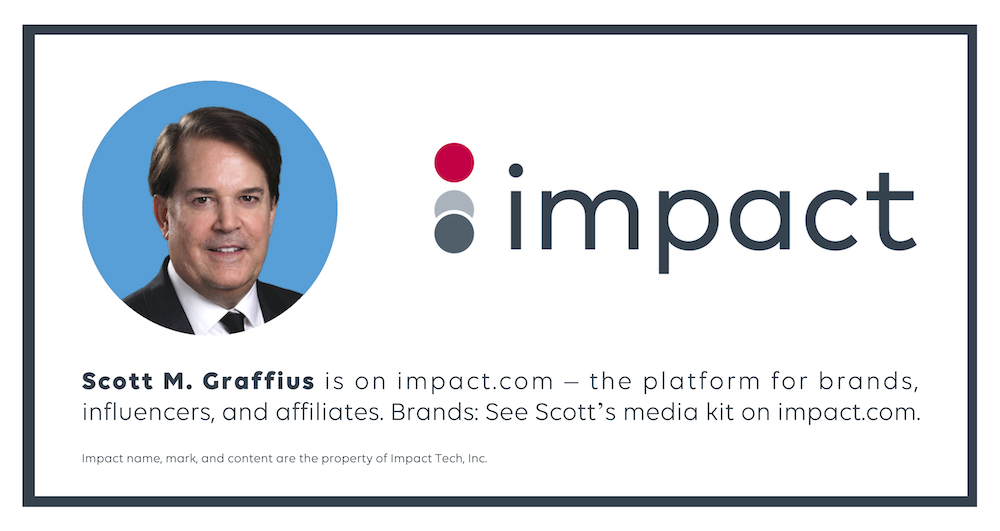

About Agile Scrum: Your Quick Start Guide with Step-by-Step Instructions

Shifting customer needs are common in today's marketplace. Businesses must be adaptive and responsive to change while delivering an exceptional customer experience to be competitive.
There are a variety of frameworks supporting the development of products and services, and most approaches fall into one of two broad categories: traditional or agile. Traditional practices such as waterfall engage sequential development, while agile involves iterative and incremental deliverables. Organizations are increasingly embracing agile to manage projects, and best meet their business needs of rapid response to change, fast delivery speed, and more.
With clear and easy to follow step-by-step instructions, Scott M. Graffius's award-winning Agile Scrum: Your Quick Start Guide with Step-by-Step Instructions helps the reader:
- Implement and use the most popular agile framework―Scrum;
- Deliver products in short cycles with rapid adaptation to change, fast time-to-market, and continuous improvement; and
- Support innovation and drive competitive advantage.
Hailed by Literary Titan as “the book highlights the versatility of Scrum beautifully.”
Winner of 17 first place awards.
Agile Scrum: Your Quick Start Guide with Step-by-Step Instructions is available in paperback and ebook/Kindle in the United States and around the world. Some links by country follow.
- 🇧🇷 Brazil
- 🇨🇦 Canada
- 🇨🇿 Czech Republic
- 🇩🇰 Denmark
- 🇫🇮 Finland
- 🇫🇷 France
- 🇩🇪 Germany
- 🇬🇷 Greece
- 🇭🇺 Hungary
- 🇮🇳 India
- 🇮🇪 Ireland
- 🇮🇱 Israel
- 🇮🇹 Italy
- 🇯🇵 Japan
- 🇱🇺 Luxembourg
- 🇲🇽 Mexico
- 🇳🇱 Netherlands
- 🇳🇿 New Zealand
- 🇳🇴 Norway
- 🇪🇸 Spain
- 🇸🇪 Sweden
- 🇨🇭 Switzerland
- 🇦🇪 UAE
- 🇬🇧 United Kingdom
- 🇺🇸 United States

About Agile Transformation: A Brief Story of How an Entertainment Company Developed New Capabilities and Unlocked Business Agility to Thrive in an Era of Rapid Change

Thriving in today's marketplace frequently depends on making a transformation to become more agile. Those successful in the transition enjoy faster delivery speed and ROI, higher satisfaction, continuous improvement, and additional benefits.
Based on actual events, Agile Transformation: A Brief Story of How an Entertainment Company Developed New Capabilities and Unlocked Business Agility to Thrive in an Era of Rapid Change provides a quick (60-90 minute) read about a successful agile transformation at a multinational entertainment and media company, told from the author's perspective as an agile coach.
The award-winning book by Scott M. Graffius is available in paperback and ebook/Kindle in the United States and around the world. Some links by country follow.
- 🇦🇺 Australia
- 🇦🇹 Austria
- 🇧🇷 Brazil
- 🇨🇦 Canada
- 🇨🇿 Czech Republic
- 🇩🇰 Denmark
- 🇫🇮 Finland
- 🇫🇷 France
- 🇩🇪 Germany
- 🇬🇷 Greece
- 🇮🇳 India
- 🇮🇪 Ireland
- 🇯🇵 Japan
- 🇱🇺 Luxembourg
- 🇲🇽 Mexico
- 🇳🇱 Netherlands
- 🇳🇿 New Zealand
- 🇪🇸 Spain
- 🇸🇪 Sweden
- 🇨🇭 Switzerland
- 🇦🇪 United Arab Emirates
- 🇬🇧 United Kingdom
- 🇺🇸 United States

© Copyright 2024 Scott M. Graffius. All rights reserved. This material may not be published, broadcast, rewritten or redistributed without the express written permission of Scott M. Graffius.

Reporting Errors in a Publication: A Case Study on ‘Frontiers in Public Health’

Any updates after this article is published will appear in the Post-Publication Notes section at the end of the article.

Introduction
Errors in published works can unleash a cascade of profound effects: they corrupt the well of knowledge, deceive those seeking truth, and shatter the foundation of credibility. As explored in the widely read article on reporting errors, taking action to address such issues plays a pivotal role in ensuring the accuracy and integrity of knowledge.
But what happens when errors go unaddressed, even after being reported with detailed evidence? This article presents a case study from Graffius’ own experience, where a publication in Frontiers in Public Health mischaracterized his research on the lifespan (half-life) of social media posts (2024 edition) and incorrectly cited his work. Despite reporting these issues to the lead author and publisher, the response—or lack thereof in this case—reveals the challenges and persistence required to uphold research integrity. Through this case study, this article illustrates the error reporting process, the importance of follow-through, and the lessons learned.
Graffius' 'Lifespan (Half-Life) of Social Media Posts' Research
When content is published on social media platforms, relevance and engagement have a limited lifespan. Most posts receive half of their total engagement (such as likes, shares, and comments) relatively soon, with the remainder spread out over a comparatively longer period. Said differently, plotting engagement against time typically reveals a distribution where the peak engagement occurs early, with a long tail of diminishing interaction, resembling a positively skewed unimodal distribution.
Given the above, an advantageous, objective metric for social media posts is half-life. It’s the time it takes for a post to receive half of its total engagement. Data can help inform strategic and tactical decisions, such as the frequency and scheduling of posts.
In 2018, Scott M. Graffius first published data on the average half-life of posts based on a large dataset comprised of multiple sources. Algorithms and other factors on platforms change over time. For that reason, Graffius periodically updates his 'Lifespan (Half-Life) of Social Media Posts' research. His work has captured the attention of, and is used by, a diverse global audience of businesses, professional associations, government agencies, universities, and others.
Errors in Frontiers in Public Health
A paper published in Frontiers in Public Health, titled 'Public perceptions of digital mental health awareness campaign in the Arab Gulf states: a qualitative thematic analysis,' inaccurately portrayed findings from the 'Lifespan (Half-Life) of Social Media Posts' research. The Frontiers authors wrongly claimed that, "the lifespan of social media posts on most platforms is, at most, 9 days," conflating 'lifespan' with 'half-life.' Their error misrepresented the research’s conclusions. Furthermore, the Frontiers paper mis-referenced Graffius’ work, citing an incorrect title and omitting the DOI, undermining the accuracy of the scholarship.
Limited excerpts from the problematic Frontiers in Public Health paper follow.

Due to its errors, the Frontiers paper misleads readers, posing a risk of misinformation that could negatively impact future research or the improper application of its findings.
Action Taken: Reporting and Following Up on the Errors
Following Graffius' own recommendation on what to do when discovering errors (available at https://scottgraffius.com/blog/files/error-reporting.html), he took action. On 18 December 2024, Graffius sent an email to the lead author, Noura Alomair, and included the editorial and publishing team at Frontiers in Public Health. The email delineated the factual error and the citation error, and it provided specific corrections for both. Excerpts from Graffius' email are shown in blue font.
1. Factual error.
The data collection section on page 03 includes this: "The lifespan of social media posts on most platforms is, at most, 9 days (19)."
However, the metric is half-life. I defined it in my research (which you cited): "The lifespan of posts is of interest, and a helpful metric is half-life. It’s the amount of time it takes for a post to receive half of its total engagement (such as likes, shares, and comments)."
Additional information — for background and context only:
- When content is published online, relevance and engagement have a limited lifespan. Engagement is typically not distributed as a normal bell curve. Rather, it’s generally a unimodal distribution-based, positively skewed curve.
- Here’s a description of the prototypical distribution of data (engagement): On average, most posts receive half of their total engagement relatively soon, with the remainder spread out over a comparatively long(er) period.
- For those reasons, an advantageous respective objective metric for posts on social media platforms is half-life. It’s the time it takes for a post to receive half of its total engagement (such as likes, shares, and comments).
- Built on a large dataset from multiple sources, Graffius’ research reveals the average lifespan (half-life) for posts on different social media platforms.
- Note: Findings from others — including anecdotal experience from select posts or otherwise the experience of one person, one organization, or a limited dataset — may vary from the average half-life data in Graffius’ research.
Accordingly, I suggest that this:
"The lifespan of social media posts on most platforms is, at most, 9 days (19)."
is corrected to this (or similar):
"Posts on top social media platforms typically receive half of their total engagement (such as likes, shares, and comments) quickly, ranging from seconds to under nine days. After that half-life point, posts start to get buried in the news feed."
2. Citation error.
Except for my work, items in the references section reflect the following template/example: "Braun V, Clarke V. Reflecting on reflexive thematic analysis. Qual Res Sport, Exerc Health. (2019) 11:589– 97. doi: 10.1080/2159676X.2019.1628806". The reference for my work is shown as: "GRAFFIUS SM. Half-life for posts on different social media platforms. (2024)." My last name is in all caps, which is not consistent with other entries. Additionally, the title is wrong, and the DOI (or, alternatively, link) is missing.
I suggest that it is corrected to this:
"Graffius SM. Lifespan (half-life) of social media posts: update for 2024. (2024). doi: 10.13140/RG.2.2.21043.60965."
Except for an auto-reply from the publisher—which promised communication "within 5 business days"—there was no response to Graffius' report of the errors. As of 20 March 2025 (the date of this article), there have been 92 days of radio silence. That's deeply concerning.
Consistent with the persistence advocated for in Graffius' own error-reporting guide, he sent a follow-up email on 20 March 2025, reiterating the errors and emphasizing the importance of research integrity. He wrote, "I imagine that, like me, you value the integrity of the academic record and would want to correct these errors to ensure the accuracy and reliability of the published work." This case study—inclusive of finding and reporting errors, getting radio silence, and more—underscores challenges of ensuring accountability in publishing.
Conclusion
As demonstrated by their action or inaction, some authors, editors, and publishers appreciate finding out about errors so that they can correct them, while others do not. The error reporting experience with Frontiers in Public Health was frustrating due to inaction from both the lead author and the publishing team. Despite providing detailed evidence and following up after 92 days of silence, Graffius has yet to receive a response. This case underscores the persistence sometimes required to uphold integrity. It also highlights the importance of taking action: while the ideal response to an error report is prompt acknowledgment and correction, the reality can be radio silence—necessitating further effort.
Whether it's enhancing the experience for future readers or upholding the accuracy and integrity of scientific works, vigilance in reporting errors plays a pivotal role.
If there is an update on this case, it will appear in the Post-Publication Notes section which appears at the end of the article.
Read on for:
- About Frontiers in Public Health,
- About Graffius' 'Lifespan (Half-Life) of Social Media Posts' Research,
- About Scott M. Graffius,
- How to Cite This Article,
- Post-Publication Notes,
- and more.

About Frontiers in Public Health
Frontiers in Public Health is a peer-reviewed, open-access journal that publishes research spanning multiple aspects of public health. Launched in 2013 by Frontiers Media, it covers topics such as health policy, epidemiology, environmental health, digital public health, and more. The journal is structured into specialty sections, including Public Mental Health, Health Economics, Aging and Public Health, and more. By fostering interdisciplinary collaboration and focused on disseminating high-quality research, Frontiers in Public Health plays a vital role in shaping public health policies and interventions worldwide.

About Graffius' 'Lifespan (Half-Life) of Social Media Posts' Research
Scientists, researchers, journalists, academics, YouTubers, podcasters, SEO experts, analysts, businesses, and others around with world feature and use Scott M. Graffius' 'Lifespan (Half-Life) of Social Media Posts' research. The current (2025) edition is available here.

About Scott M. Graffius

Scott M. Graffius sparks breakthroughs in AI, agile, and project management/PMO leadership as a globally recognized practitioner, researcher, thought leader, award-winning author, and international public speaker.
Graffius has generated more than USD $1.9 billion in business value for organizations served, including Fortune 500 companies. Businesses and industries range from technology (including R&D and AI) to entertainment, financial services, and healthcare, government, social media, and more.
Graffius leads the professional services firm Exceptional PPM and PMO Solutions, along with its subsidiary Exceptional Agility. These consultancies offer strategic and tactical advisory, training, embedded talent, and consulting services to public, private, and government sectors. They help organizations enhance their capabilities and results in agile, project management, program management, portfolio management, and PMO leadership, supporting innovation and driving competitive advantage. The consultancies confidently back services with a Delighted Client Guarantee™. Graffius is a former vice president of project management with a publicly traded provider of diverse consumer products and services over the Internet. Before that, he ran and supervised the delivery of projects and programs in public and private organizations with businesses ranging from e-commerce to advanced technology products and services, retail, manufacturing, entertainment, and more. He has experience with consumer, business, reseller, government, and international markets.
He is the author of two award-winning books.
- His first book, Agile Scrum: Your Quick Start Guide with Step-by-Step Instructions (ISBN-13: 9781533370242), received 17 awards.
- His second book is Agile Transformation: A Brief Story of How an Entertainment Company Developed New Capabilities and Unlocked Business Agility to Thrive in an Era of Rapid Change (ISBN-13: 9781072447962). BookAuthority named it one of the best Scrum books of all time.
Prominent businesses, professional associations, government agencies, and universities have featured Graffius and his work including content from his books, talks, workshops, and more. Select examples include:
- Adobe,
- American Management Association,
- Amsterdam Public Health Research Institute,
- Bayer,
- BMC Software,
- Boston University,
- Broadcom,
- Cisco,
- Coburg University of Applied Sciences and Arts Germany,
- Computer Weekly,
- Constructor University Germany,
- Data Governance Success,
- Deimos Aerospace,
- DevOps Institute,
- EU's European Commission,
- Ford Motor Company,
- GoDaddy,
- Harvard Medical School,
- Hasso Plattner Institute Germany,
- IEEE,
- Innovation Project Management,
- Johns Hopkins University,
- Journal of Neurosurgery,
- Lam Research (Semiconductors),
- Leadership Worthy,
- Life Sciences Trainers and Educators Network,
- London South Bank University,
- Microsoft,
- NASSCOM,
- National Academy of Sciences,
- New Zealand Government,
- Oracle,
- Pinterest Inc.,
- Project Management Institute,
- SANS Institute,
- SBG Neumark Germany,
- Singapore Institute of Technology,
- Torrens University Australia,
- TBS Switzerland,
- Tufts University,
- UC San Diego,
- UK Sports Institute,
- University of Galway Ireland,
- US Department of Energy,
- US National Park Service,
- US Tennis Association,
- Veleučilište u Rijeci Croatia,
- Verizon,
- Virginia Tech,
- Warsaw University of Technology,
- Wrike,
- Yale University,
- and many others.
Graffius has been actively involved with the Project Management Institute (PMI) in the development of professional standards. He was a member of the team which produced the Practice Standard for Work Breakdown Structures—Second Edition. Graffius was a contributor and reviewer of A Guide to the Project Management Body of Knowledge—Sixth Edition, The Standard for Program Management—Fourth Edition, and The Practice Standard for Project Estimating—Second Edition. He was also a subject matter expert reviewer of content for the PMI’s Congress. Beyond the PMI, Graffius also served as a member of the review team for two of the Scrum Alliance’s Global Scrum Gatherings.
Graffius has a bachelor’s degree in psychology with a focus in Human Factors. He holds eight professional certifications:
- Certified SAFe 6 Agilist (SA),
- Certified Scrum Professional - ScrumMaster (CSP-SM),
- Certified Scrum Professional - Product Owner (CSP-PO),
- Certified ScrumMaster (CSM),
- Certified Scrum Product Owner (CSPO),
- Project Management Professional (PMP),
- Lean Six Sigma Green Belt (LSSGB), and
- IT Service Management Foundation (ITIL).
He is an active member of the Scrum Alliance, the Project Management Institute (PMI), and the Institute of Electrical and Electronics Engineers (IEEE).
He divides his time between Los Angeles and Paris, France.
Thought Leader | Public Speaker | Agile Scrum Book | Agile Transformation Book | Blog | Photo | X | LinkedIn | Email


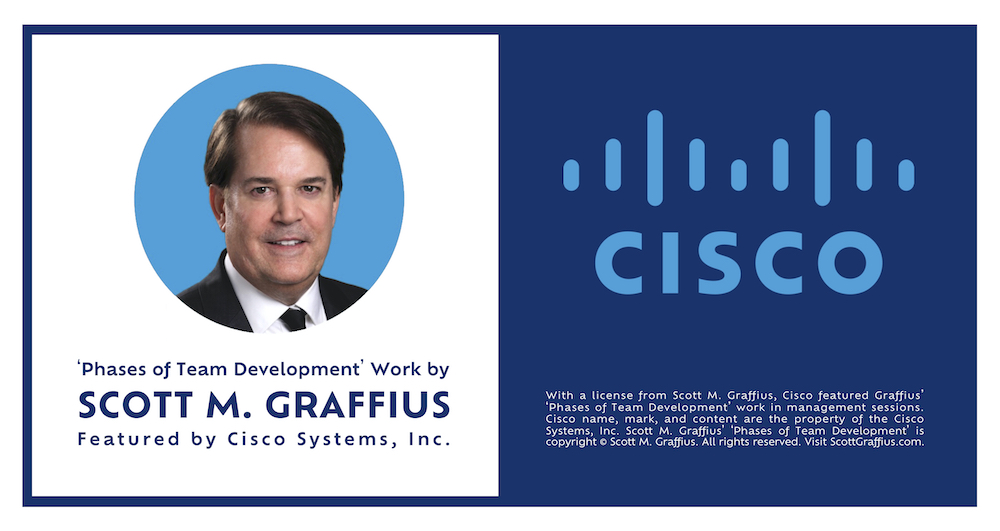










Sign up for Miro—it's free!
(Want more features? You can always upgrade to a paid plan.)


How to Cite This Article
Graffius, Scott M. (2025, March 20). Reporting Errors in 'Frontiers in Public Health': A Case Study. Available at: https://scottgraffius.com/blog/files/reporting-errors-in-frontiers-of-public-health-publication.html. 

Digital Object Identifier (DOI)
DOI: (coming soon)

Content Acknowledgements
This article includes brief excerpts from Frontiers in Public Health ('Public perceptions of digital mental health awareness campaign in the Arab Gulf states: a qualitative thematic analysis' by Noura Alomair, Ghadah Alkhaldi, Norah M. Alsadhan, Rawan Alkasabi, and Samah Alageel), attributed and used under fair use for news reporting and analysis.
Frontiers in Public Health is the property of Frontiers Media S.A.
Graffius’ Lifespan (Half-Life) of Social Media Posts' is copyright © Scott M. Graffius. All rights reserved.

Post-Publication Notes
If there's an update after this article is published, the information will appear here.
Update on 24 March 2025
On 24 March 2025, Frontiers (the publisher) sent an email to Graffius. Here’s an excerpt:
"This is to let you know that the corresponding author has submitted a corrigendum for the article based on your comments. Our editorial team will review the corrigendum."
Update on 24 March 2025
On 24 March 2025, Graffius replied to Frontiers’ email. Here’s an excerpt:
"Please:
1. Inform me know when you’re scheduled to implement the corrections (or an estimated date), and
2. Update me after you’ve implemented the corrections."
Update on 25 March 2025
On 25 March 2025, Frontiers (the publisher) sent an email to Graffius. Here’s an excerpt from it:
"If the corrigendum is accepted, I will send you the link to the online page. There will also be a visible link to the Corrigendum on the original article, as soon as the article is accepted. Once an article is accepted, they are published within 3 weeks on average. Please note that once an article is updated, it can take longer for the update to be reflected in certain repositories, depending on the repository."
Update on 28 March 2025
The most recent update from the publisher was on 25 March 2025. It's noted above.
For context, Graffius reported the errors on 18 December 2024. As of today, that was 100 days ago, and the errors have not yet been resolved. 

Copyright
Copyright © Scott M. Graffius. All rights reserved.
Content on this site—including text, images, videos, and data—may not be used for training or input into any artificial intelligence, machine learning, or automatized learning systems, or published, broadcast, rewritten, or redistributed without the express written permission of Scott M. Graffius.
